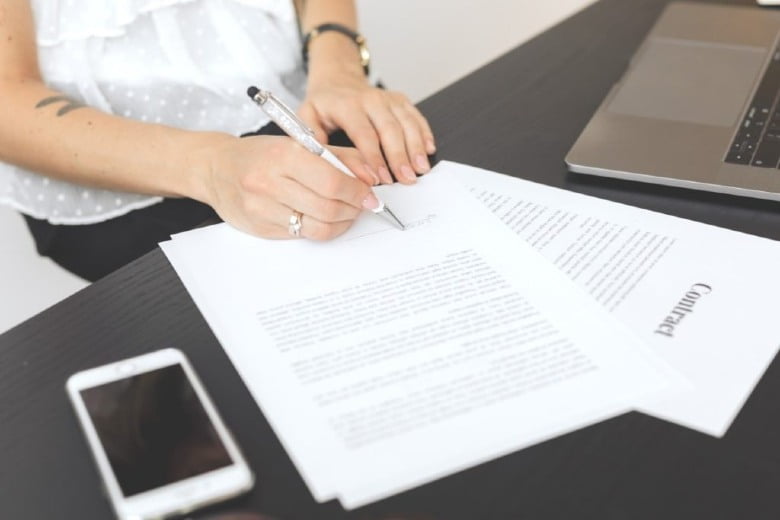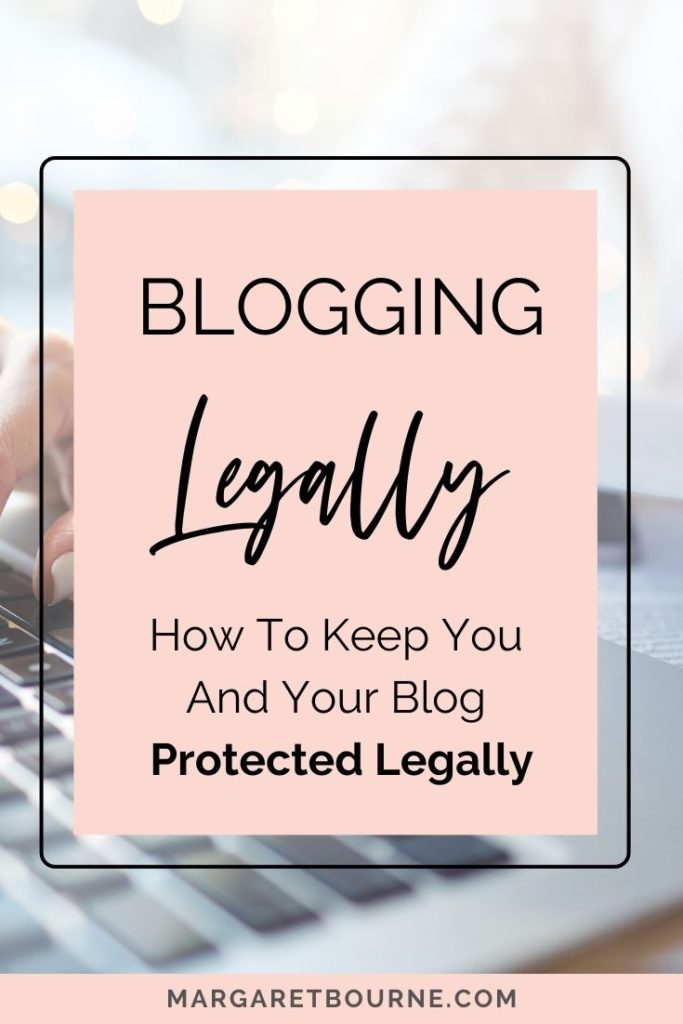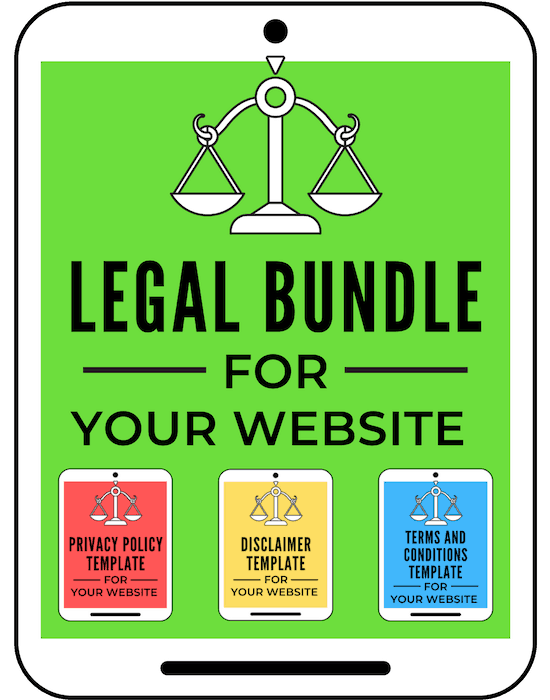
Are you blogging legally? It can seem like the most daunting part of it all, but it’s so important to legally protect your blog, website or online business. Blogging legally and having the right legal pages for blogs are just small vital steps to protecting yourself and your blog from potential risks in 2024.
Blogging legally can seem like an extra hassle and expense. However, it can greatly impact your blog and its growth.
Learning how to blog legally will open up opportunities (monetization) and give you peace of mind. I sleep much easier now than I did before because of the steps I took to protect my blog legally with the necessary legal pages for websites.
For many years, I used a free Privacy document and a Disclosure that I had cobbled together from looking at other bloggers’ legal pages. Bad me – this is a big no-no!
Blogging legally was my goal, but I just didn’t have access to legal help that didn’t cost an arm and a leg. But when I started building an email list, adding affiliate links and monetizing my blog, I knew it was high time to cover my ass legally.
It was time to add proper legal pages for my blog.
You should have legal pages from the moment you start your blog and officially launch it.
Blogging can be a risky business. Although it may seem the chances of being sued are low, you never know when you accidentally come across somebody who decides to sue you for a valid reason (we’ll explore these some more below).
And nobody wants to be sued. Right? Of course, right?
This post is for anybody who is a hobby blogger, one dabbling in making it into a business, and those who are actively using a blog to promote their business, such as a coaching business.
DISCLOSURE: This post contains affiliate links, meaning if you click on a product or service, and decide to purchase it, I may receive a commission at no extra cost to you. All recommended products and services are based on my positive experience with them. For more information, please read my Disclaimer.

Blogging Legally: Five Key Ways To Legally Protect Your Blog
In this post, we’ll explore four key ways to protect your blog legally. I’ll also share my thoughts about my experience with the legal pages for blogs from A Self Guru – the popular Legal Bundle.
Best of all, learning how to blog legally is not going to be too difficult! I promise…
1. Have Your Legal Pages On Your Blog
Blogging legally means you have to have the necessary three key legal pages for websites on your blog:
- Privacy Policy
- Disclaimer
- Terms & Conditions
We’ll go through each of these and explain the details, but for now, let’s understand why you need them.
Simply put, you need to have them on your blog (even before you officially launch – and if you don’t have them with your current blog… what are you waiting for?) to comply with the laws, and to protect yourself and your blog from lawsuits.

| RELATED: How To Successfully Start A Blog And Get It Ready For Growth
Don’t Copy Legal Pages For Blogs: Copyright Infringement!
So you think, why not copy somebody else’s legal pages?
Hold on! That would be copyright infringement. No can do! This is not the way to blog legally.
You could try writing your own BUT, unless you’re a lawyer, you won’t include all the necessary information that protects you and your blog legally.
What’s the solution? A little help from a blogger who’s also a lawyer. Amira’s (A Self Guru) Legal Bundle is the easiest (AND least expensive) way to add customizable legal pages for your blog. Amira is not only a blogger but also a REAL, practicing lawyer.
The Legal Bundle is the most cost-effective way to legally protect your blog by ensuring you have the three key legal documents on your site.
If I went to my lawyer (who’s a lovely man, and always very helpful in legal matters), I would have to pay at least triple the amount for ONE of the pages by Amira.
I don’t have over $3,000+ to cover the costs of getting my lawyer to write up these three important documents. Thank goodness for the much more affordable Legal Bundle from Amira.
She’s prepared the bundle, which includes the Privacy Policy, Disclaimer, and Terms & Conditions, with bloggers and their budgets in mind.
But first, back to why we need the legal pages for your blog in the first place.
Privacy Policy
One of the ways to legally protect your blog is to have a Privacy Policy in place. This important document tells the visitor to your site about how you collect and use their personal information. The law requires you to disclose this information.
Whether you have a blog, website or online business, you need to let people know how you are using their personal information. You can’t bypass this – you open yourself up to the potential of being sued if you’re missing this.
The Privacy Policy needs to cover several key points:
- Compliance with the CAN-SPAM Act
- Let your visitors from the (European Union) EU know about how personal data is collected due to the GDPR – General Data Protection Regulation, which came into effect a few years ago.
- Information about how you collect emails through email marketing services (e.g., Mailerlite, etc.)
See why you need help via the Legal Bundle? Who wants to struggle to make sure you’re covered for all of this?
Disclaimer
A second way to legally protect your blog is to have a Disclaimer page.
What does a Disclaimer do? It tells your readers what the limits are to what they can or can’t do with the information, products, and services you share on your site.
It’s important to have this to ensure that you don’t get sued by somebody claiming they used information from you or your blog as professional advice.
You see the little disclaimer at the top that claims I’m not a lawyer… this is to protect myself from anybody claiming that I’ve provided them legal advice.
Aside from noting any content on your site is not professional advice, a Disclaimer informs about affiliate programs and third-party links.
It also informs about any financial income (commissions, payments) you get from purchases somebody makes from your affiliate links. This is also important to comply with the FTC and their strict rules.
Amira goes into greater detail on her A Self Guru blog. It’s a worthwhile read if you’re interested in learning more about Disclaimer pages.
PRO TIP: You can also use this disclaimer page in a link on your digital downloads if you’re adding affiliate links to them.
Terms & Conditions
The Terms & Conditions page tells users about your website’s rules. As Amira notes on her blog,
“They encompass your Privacy Policy and Disclaimer and serve as an agreement between you and anyone that visits, uses or purchases from your website.”
Amira – A Self Guru
The Terms & Conditions cover your intellectual property rights, how you can terminate somebody’s usage of your site at your own discretion, the intended age of site visitors, refund and exchange policies relating to your products, and resolution of disputes.
TIP: Add a link to your Terms & Conditions to your digital downloads, so that others know how they can use them. This helps with copyright issues.
My Experience With The Legal Bundle
There are several reasons why I’ve chosen and recommend A Self Guru’s Legal Bundle, and why you may want to too:
- I knew I needed to legally protect my blog but it was overwhelming to do so on my own
- I’m not a lawyer but she is, and she knows her stuff when it comes to protecting yourself legally while blogging. She uses them on her own site.
- It takes guesswork and hours of pulling my hair out trying to figure out the intricacies of legal pages for blogs
- It’s super easy to customize to your own blog/business niche
- What a fantastic deal! It doesn’t cost an arm and a leg, and it comes with 9 amazing bonuses (worth over $1000!!) and access to a private Facebook support group
- Once you’ve purchased it, you can use the pages on any of the websites and blogs you own
A small investment in purchasing the Legal Bundle can save you thousands down the line, in case you get sued!
Remember: you can’t just copy the pages and use them on your own site. These are protected under copyright laws.
2. Make Your Site Accessible
What does this mean?
You’ve probably heard that your site needs to be compliant with accessibility laws (ADA compliant).
This means you’re consciously making it easier for the visually impaired to experience your site.
Being compliant with ADA laws is important. In recent years there have been many lawsuits brought forth against websites and even bloggers for not being compliant with ADA laws.
To understand what you need to do, and to have an Accessibility Statement on your site, I recommend you pick up this ADA website legal bundle.
It easily breaks down the laws and your responsibilities, a checklist of what you can easily do to improve your site, and an accessibility statement template.
3. Always Create Original Content
Next on the list of tips for blogging legally is one that everybody should be doing.
I still see many bloggers doing this. Including several who have copied THIS blog post and been caught doing it.
Stealing content from other bloggers is a copyright violation: it’s theft, pure and simple.
It’s a cheap way for cheaters to get ahead, but it can be very costly when caught. Never steal content from others!
One way to legally protect your blog and yourself from being sued is to create original work. What you learned in school about plagiarism applies to blogging and real life as well.
I have had complete blog posts duplicated by others – and I’ve gone after them to remove them ASAP. It’s never pleasant to see somebody achieving success based on YOUR work.
It’s so important to blog legally by creating original content.
The moment you create your work, it’s protected in the US (Copyright.gov site).
In Canada, you the author of the blog, are the owner of the blog. An author of a blog post is the owner of the blog post. The Food Bloggers of Canada has a great write-up of the Canadian copyright laws for bloggers.
With original content, you are not only protecting yourself legally but also being genuine.
Cheating is never satisfying in the end, and you can potentially lose followers if it gets out that you’re stealing from other blogs. And bloggers talk. You can potentially be blacklisted by brands if they hear about any scandals related to plagiarism.
Be you. Be legal.
| Related: 50+ Sources Of Inspiration For Fresh Blog Content
4. When Using Others’ Work, Seek Permission & Provide Credit
Another key way of legally protecting your blog is to make sure you aren’t stealing from others. If for any reason you need to use somebody’s content, photos… anything that’s not yours, it’s always good to ask if you can use it.
In many cases, bloggers will be happy to let you use the content as long as it links back to their site (a do-follow link) and includes their name.
Giving credit where credit is due is key to keeping you from becoming a plagiarist and breaking the law.
Ask them how they want to be credited and follow through.
Here’s an example of content that you might need to use from another blogger:
You attend an event where other bloggers are in attendance. One of them takes a photo you’d like to use on your site or social media.
Send them an email or message to ask if you can use it on your site or social media accounts and how they would like to be credited.
Here’s an additional tip: ALWAYS keep a copy of the approval in your files in case the blogger forgets and accuses you of using their photo without permission. I’ve seen it happen.

5. Use Copyright-Free Photos On Your Blog Or Website
Speaking of photos, always use copyright-free photos! Although you may be tempted to “borrow” a photo from Google images, you need to be aware that they may be copyrighted photos.
You may also think if another blogger is using a photo then it’s copyright-free. But that may not be the case and if you use it, you’ll be doing something illegal.
One of the key ways to protect your blog legally is to always ensure you seek them from reputable stock photography companies.
They offer copyright-free photos either with paid options or free stock photos (where usually all that’s required is crediting the photographer).
I’m stressing reputable sites because a few years ago, there was a “stock photo” site that was lifting photos from bloggers’ sites (via Google) and passing them off as copyright-free.
Not only was it stealing bloggers’ original photos, but also potentially sharing copyrighted photos from professional photographers.
To be on the safe side and blog legally, work with paid stock photography sites as they ensure they have permission from photographers.
Stock Photos And Digital Products
Be careful to use stock photos in the digital products you sell or offer as freebie lead magnets you create.
Read the specifics in your license as to what you can and can’t do with them. In many cases, you will need to modify the images.
PRO TIP: When using stock photos, always read the fine print. Find out if you need to credit the photographer.
| RELATED: 50+ Resources & Tools For Bloggers Including Stock Photo Sites
Legal Pages And Documents For Coaches
If you’re providing coaching services and using a blog or website to promote them, you still need the necessary legal pages for websites.
In addition to this, you should have a coaching agreement in place. Read more about why you should have a customizable coaching agreement template if you’re working with clients.
Read this starting a coaching business checklist with all the key steps you need to take before you launch it.
And read what key online coaching tools I recommend that have helped me build my business!
To Recap: How To Blog Legally
So that’s it! Five easy and effective ways to legally protect your blog.
- Create your own content: don’t plagiarize
- Ask for permission to use other’s content and credit them (and link back to them if possible)
- Use copyright-free stock photos – select, reputable free stock photography sites, and paid stock photo site
- Be ADA compliant
- Most importantly, have key legal pages for blogs: add your Privacy Policy, Disclaimer, and Terms & Conditions pages
The first three things you’ll need to keep doing to blog legally. The last two things you do once and only update as needed.
Having a legally protected blog is one of the most important things any blogger can have.
We all want to reduce any risks associated with a growing, successful money-making blog, and blogging legally is one of the best things you’ll do.
By implementing these four points, you’ll be on your way! I know I’m resting much easier knowing I blog legally.
QUESTION: What is the thing that you worry about most when it comes to legally protecting your blog?
Feature photo credit: Monika Grabowska, Kaboompics
Like this post? Share it on Pinterest! Thank you.



Hi there,
Firstly, thank you so much for this blog – it is so helpful and my ‘go to’ for help!
This question may have an obvious answer but I can’t find it anywhere on the internet!
How do you get photos for transactional posts? I’m at the early stage where I’ve got review posts up with non affiliate links and my own photos of the products. I’ve just been approved for a affiliate network and can now swap those links out for affiliate ones 🎉
I’m now starting to write gift guides but have no idea how to do the photos?
Can I use the product photo from the company’s website eg a Christmas skincare gift box from Sephora etc?
I see blog posts like this ALL the time especially leading up to Christmas and have no idea how they do it! Their product photos do appear to be from the website’s promotional pages, but have no idea if you can just use/take them as you want?
I would never consider taking anyone else’s general photos but just don’t know when it comes to product photos of products you are promoting? Most of the time I promote the product used myself, so I can take my own photos, but that’s not the case with gift guides.
Thanks in advance
Katy
Hey Katy,
Ideally it should be photos that you took yourself. The best way to get around this is to see if it’s an affiliate product with existing visuals for products. This is what Good Housekeeping has done – see their gift guide with Amazon products. https://www.goodhousekeeping.com/holidays/gift-ideas/a41936982/best-gift-ideas/ An alternative is that you reach out to their PR/press contact and see if they have an outreach list for their Holiday gift ideas and if you could be on it. Let them know which images you’d like to use and ask if you have permissions (with crediting them for the photo etc.).
Thank you for the tips Margaret! It’s important to stay protected as a blogger.
Definitely saving this for later. I need to address some of this on my blog.
You’ll sleep easier having done it!
Awesome tips! Legal protection is a MUST for all bloggers.
100% agree!
So important and such great tips for best practices.
Absolutely! It’s a must for good blogging.
This was something on my to do list for my blog and website. Thank you for all the helpful advice!
You’re welcome! 🙂
This is super helpful! I’ve been looking into the legal aspects of blogging and I need to get those privacy policies and discloser pages ready! I didn’t know where to look or how to start. This is great! Thank you!
these are great tips and very useful ! Thanks for sharing this , will try to implement them!
-The Handy Journal-